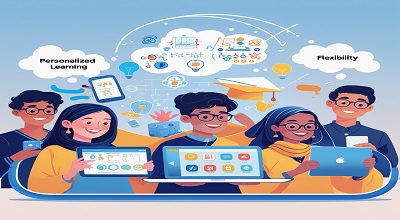Advantages of Mobile Learning
Advantages of Mobile Learning: Mobile learning, often referred to as m-learning, has revolutionized the way education is delivered and consumed. With the proliferation of smartphones and tablets, learners can access educational content anytime and anywhere. This article explores the advantages of mobile learning, providing examples and insights into its impact on education and training.
Accessibility Anytime, Anywhere
One of the most significant advantages of mobile learning is its accessibility. Learners can engage with educational materials at their convenience, whether they are at home, commuting, or travelling. This flexibility allows for a more personalized learning experience.
Example:
A student can review lecture notes or watch instructional videos during their commute, turning travel time into productive study time. This is particularly beneficial for those with busy schedules, as they can fit learning into their daily routines without the constraints of traditional classroom settings.
Enhanced Engagement Through Interactive Content
Mobile learning platforms often incorporate interactive elements such as quizzes, videos, and gamified content. This interactivity keeps learners engaged and motivated, making the learning process more enjoyable.
Example:
An online course might include interactive simulations that allow students to practice real-world scenarios, such as medical students using apps to simulate patient interactions. This hands-on approach enhances understanding and retention of complex concepts.
Immediate Feedback and Assessment
Mobile learning enables instant feedback on assessments and quizzes. Learners can quickly gauge their understanding of the material and identify areas that need improvement.
Example:
A language learning app might provide immediate corrections and suggestions after a user completes a speaking exercise, allowing them to adjust their pronunciation and grammar in real-time. This immediate feedback loop is crucial for effective learning.
Cost-Effectiveness
Mobile learning can be more cost-effective than traditional education methods. With the ability to access materials online, institutions can reduce costs associated with physical textbooks and classroom space.
Example:
Many online courses offer free or low-cost access to learning materials, making education more affordable for students. For instance, platforms like Coursera and edX provide courses from top universities at a fraction of the cost of traditional tuition.
Personalized Learning Experiences
Mobile learning allows for personalized learning paths tailored to individual needs and preferences. Learners can choose what, when, and how they study, leading to a more effective educational experience.
Example:
A student struggling with a particular math concept can access targeted resources, such as video tutorials or practice problems, specifically designed to address their weaknesses. This adaptability is a significant advantage over one-size-fits-all classroom instruction.
Increased Collaboration and Communication
Mobile learning fosters collaboration among learners and instructors through various communication tools. Discussion forums, chat features, and collaborative projects can enhance the learning experience.
Example:
Students can work together on group projects using mobile apps that allow for real-time collaboration, such as Google Docs or Slack. This not only improves teamwork skills but also helps learners gain diverse perspectives on the subject matter.
Microlearning Opportunities
Mobile learning supports microlearning, which involves breaking down content into small, manageable chunks. This approach is particularly effective for busy learners who may not have time for lengthy study sessions.
Example:
A professional development app might offer short, focused lessons on specific skills, such as time management or effective communication, that can be completed in just a few minutes. This method enhances retention and makes learning more digestible.
Support for Diverse Learning Styles
Mobile learning accommodates various learning styles, allowing learners to engage with content in ways that suit them best. Whether through visual, auditory, or kinesthetic methods, mobile platforms can cater to individual preferences.
Example:
An educational app might provide video lectures for visual learners, podcasts for auditory learners, and interactive exercises for kinesthetic learners, ensuring that all students can benefit from the material.
Continuous Learning and Development
With mobile learning, education does not have to stop after formal schooling. It promotes a culture of lifelong learning, enabling individuals to continue developing their skills throughout their lives.
Example:
Professionals can use mobile learning platforms to stay updated on industry trends and acquire new skills relevant to their careers, such as learning new software or management techniques.
More Here: Fishing Master MOD APK
Global Reach and Inclusivity
Mobile learning breaks down geographical barriers, allowing learners from different parts of the world to access quality education. This inclusivity is vital for promoting equal opportunities in education.
Example:
A student in a remote area can participate in an online course offered by a prestigious university, gaining access to resources and knowledge that would otherwise be unavailable to them.
Conclusion
The advantages of mobile learning are numerous and impactful, transforming the educational landscape. From accessibility and engagement to cost-effectiveness and personalized experiences, mobile learning offers a flexible and effective approach to education. As technology continues to evolve, the potential for mobile learning will only expand, making it an essential component of modern education.
FAQs
1. What is mobile learning?
Mobile learning, or m-learning, refers to the use of mobile devices to access educational content and engage in learning activities anytime and anywhere.
2. How does mobile learning enhance engagement?
Mobile learning enhances engagement through interactive content, such as quizzes and gamified elements, which make the learning experience more enjoyable and motivating.
3. Can mobile learning be cost-effective?
Yes, mobile learning can be cost-effective as it reduces the need for physical materials and allows access to free or low-cost online courses.
4. How does mobile learning support personalized learning?
Mobile learning supports personalized learning by allowing learners to choose their study paths, access targeted resources, and learn at their own pace.
5. Is mobile learning suitable for all age groups?
Yes, mobile learning is suitable for all age groups, from school students to professionals seeking to enhance their skills, as it accommodates diverse learning styles and preferences.
